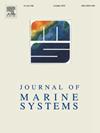Pathways of organic carbon mineralization and benthic fluxes of alkalinity and dissolved inorganic carbon in sediments of large inland seas: The Bohai Sea and North Yellow Sea
IF 2.5
3区 地球科学
Q2 GEOSCIENCES, MULTIDISCIPLINARY
引用次数: 0
Abstract
Shallow inland seas are sensitive to benthic-pelagic coupling and susceptible to anthropogenic perturbations. In the sediments, organic carbon (OC) mineralization-driven diagenetic cycling and benthic-pelagic coupling are impacted by numerous intricate factors, many of which have not been well documented. In this study, conventional geochemical measurements and multicomponent-coupled diagenetic modeling are combined to quantitatively investigate the partitioning of OC mineralization among individual electron acceptors in sediments of two large inland seas: the Bohai Sea (BHS) and the North Yellow Sea (NYS). We then estimate OC transfer efficiency in the sediments and benthic fluxes of dissolved inorganic carbon (DIC) and total alkalinity (TA). Modeling results suggest that the reactivity of sedimentary OC is 1–3 orders of magnitude lower than the most commonly observed values, indicating overall low degradability of OC. Depth-integrated OC mineralization rates over a 20-cm depth are 3.4 and 2.4 mmol m−2 d−1 on average in the BHS and NYS sites, respectively, with aerobic respiration as the most important pathways (mean: 54 %), followed by sulfate reduction (mean: 24 %). Dissimilatory iron reduction (DIR), dissimilatory manganese reduction (DMR), and denitrification combined contribute only 16 %–33 % of OC mineralization. Sedimentation rate, rather than OC mineralization rate, is the primary control of OC transfer efficiency in the sediments. Consequently, high sedimentation rates in the BHS result in much higher OC transfer efficiency (mean: 78 %) over the 20-cm depth of the sediment compared to that in the NYS (mean: 34 %). Albeit covering a relatively small area, these two inland seas represent hotspots of OC burial. Our estimates of benthic fluxes suggest that benthic exports of DIC and TA may play an important role in benthic-pelagic coupling in these seas. Contrasting TA/DIC flux ratios imply that benthic TA export may mitigate bottom-water acidification in the BHS but exacerbate the acidification in the NYS.
大内海沉积物中有机碳矿化途径及碱度和溶解无机碳底栖通量:渤海和北黄海
浅海对底-上层耦合很敏感,对人为扰动也很敏感。在沉积物中,有机碳(OC)矿化驱动的成岩旋回和底-远洋耦合受到许多复杂因素的影响,其中许多因素尚未得到很好的记录。本文采用常规地球化学测量和多组分耦合成岩模拟相结合的方法,定量研究了渤海和北黄海两大内陆海沉积物中各电子受体之间的有机碳矿化分配。然后,我们估算了沉积物中的OC转移效率以及溶解无机碳(DIC)和总碱度(TA)的底栖通量。模拟结果表明,沉积OC的反应性比最常见的观测值低1-3个数量级,表明OC的整体可降解性较低。在BHS和NYS位点,20厘米深度上的深度积分OC矿化率平均分别为3.4和2.4 mmol m−2 d−1,有氧呼吸是最重要的途径(平均值:54%),其次是硫酸盐还原(平均值:24%)。异化铁还原(DIR)、异化锰还原(DMR)和反硝化作用加在一起只贡献了16% - 33%的OC矿化。沉积物中OC转移效率的主要控制因素是沉积速率,而不是OC矿化速率。因此,BHS的高沉积速率导致沉积物在20厘米深度上的OC转移效率(平均值:78%)远高于NYS(平均值:34%)。虽然面积相对较小,但这两个内陆海代表了有机碳埋藏的热点。我们对底栖生物通量的估计表明,底栖生物输出的DIC和TA可能在这些海域的底-上层耦合中起重要作用。对比TA/DIC通量比表明,底栖动物TA输出可以缓解BHS的底水酸化,但会加剧NYS的酸化。
本文章由计算机程序翻译,如有差异,请以英文原文为准。
求助全文
约1分钟内获得全文
求助全文
来源期刊

Journal of Marine Systems
地学-地球科学综合
CiteScore
6.20
自引率
3.60%
发文量
81
审稿时长
6 months
期刊介绍:
The Journal of Marine Systems provides a medium for interdisciplinary exchange between physical, chemical and biological oceanographers and marine geologists. The journal welcomes original research papers and review articles. Preference will be given to interdisciplinary approaches to marine systems.
 求助内容:
求助内容: 应助结果提醒方式:
应助结果提醒方式:


